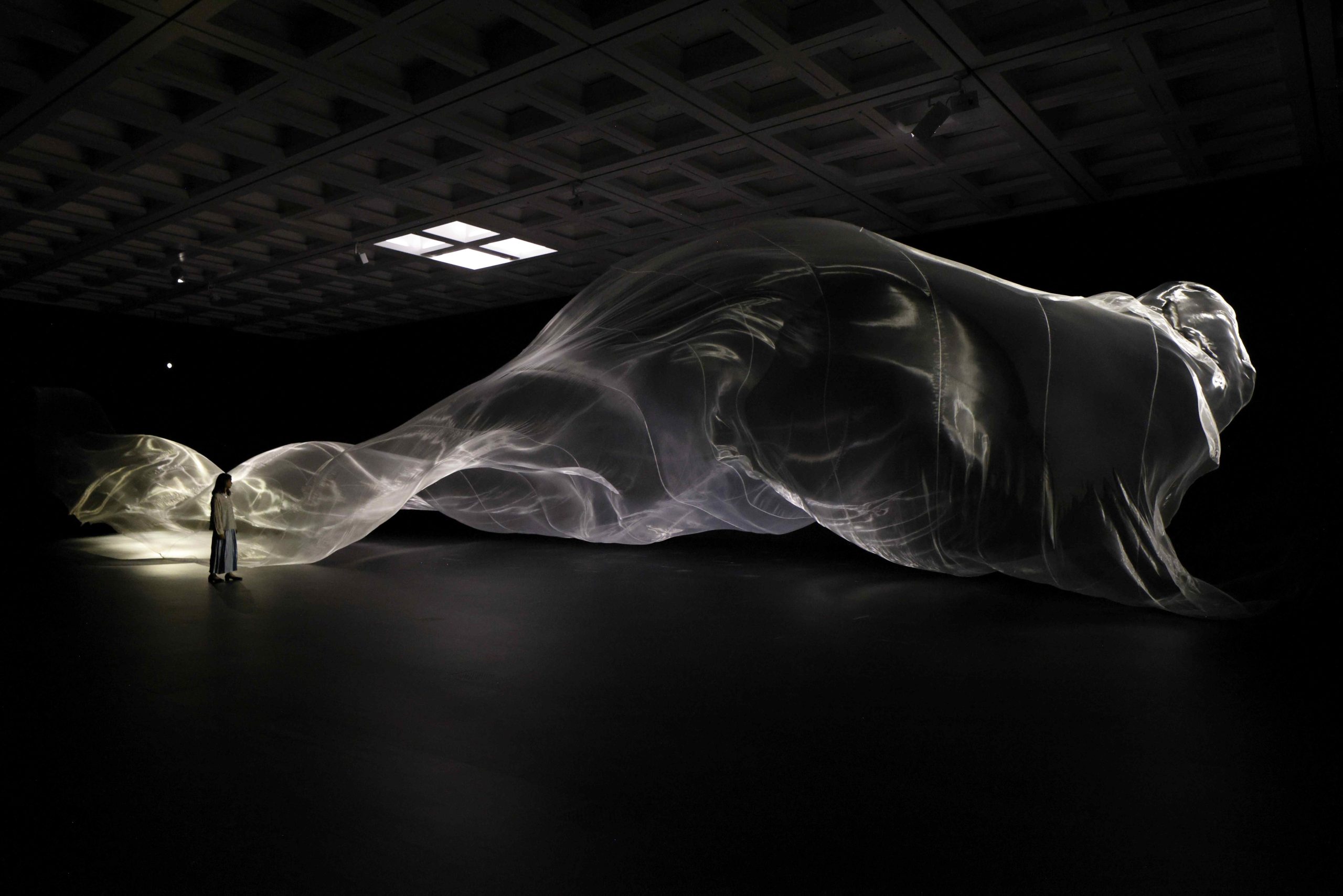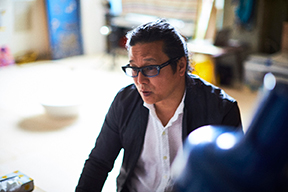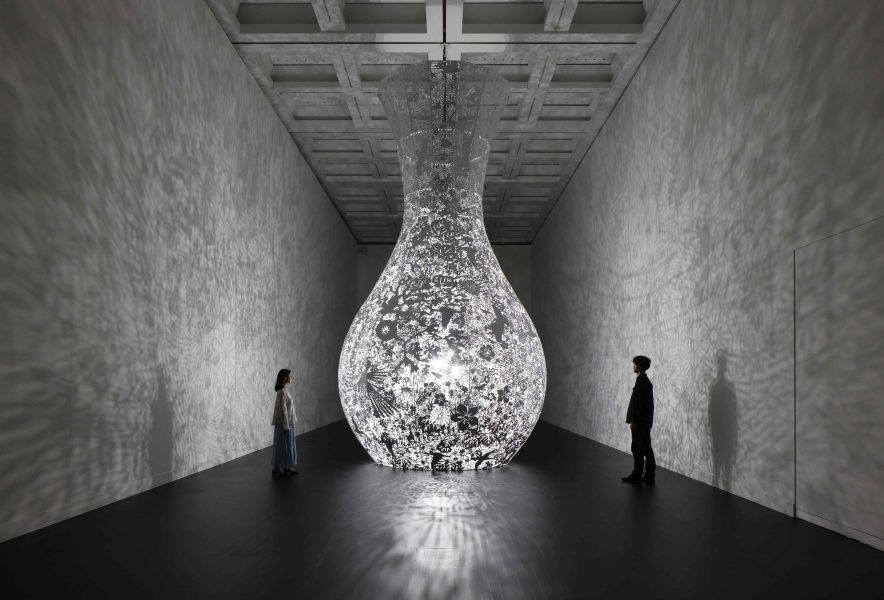Shinji Ohmaki is known for creating large-scale installations that inquire into the nature of being and disrupt the somatic senses of viewers. He has presented these ambitious works to high acclaim not only in Japan but also in many other countries across Asia and Europe. In addition, he applies his unparalleled gifts in diverse settings ranging from the performing arts to projects that revitalize local communities, working with a host of collaborators to transform each site.
Engulfed in one of Ohmaki’s spaces, we find ourselves examining our own presence in the world from fresh perspectives. By leaving vestiges of ourselves in these spaces, we arrive at tangible realizations of our own physicality. Whether enveloped in darkness or illuminated by intense light, we are urged to introspectively confront not only our bodies but also our minds and senses.
Ohmaki contemplates the historical arc that has led contemporary society to its current state and the issues it now faces, drawing on these reflections as a source of inspiration for his installations. Ohmaki’s spaces, in which light and darkness play key roles, are infused with a sense of primeval life governed by celestial rhythms. This air of the primordial inter- mingles with the dazzling yet delicate decorative imagery that also features prominently in the artist’s practice. His imagery reflects the way in which human beings throughout history have surrounded themselves with abstract patterns derived from nature and, by doing so, have engaged closely with the natural world. Even as they offer astute critiques of contemporary society, Ohmaki’s installations vividly reflect humanity’s fundamental, timeless and universal artistic inclinations.
This exhibition is staged dynamically in the largest gallery at The National Art Center, Tokyo, with a ceiling height of eight meters and floor space of 2,000 square meters. The installations, which can only be presented in such an expansive venue, resonate with us on a profoundly physical level, evoking a sense of organic integration that we have lost in our fragmented world. The elements of video, sound, and poetry will be further augmented by performances in the venue. We invite you to immerse yourself in Ohmaki’s composite art for the contemporary era.
Term: November 1 (Wed), 2023 – December 25 (Mon), 2023
Open: 10:00-18:00
*10:00-20:00 on Fridays and Saturdays
(Last admission 30 minutes before closing)
Admission (tax included): Free
The National Art Center, Tokyo official website: https://www.nact.jp/english/
Exihibition Highlights
1. Installations Reflecting Ohmaki’s Deepening Psychological Exploration
In addition to the latest version of the series Gravity and Grace, initiated in 2016, this exhibition present new works rooted in fundamental questions surrounding our reasons for living.
The Great East Japan Earthquake, tsunami and Fukushima nuclear power plant disaster of March 11, 2011 had a profound impact on Ohmaki. In Gravity and Grace, Ohmaki interrogates our society’s attempts to wield the double-edged sword of nuclear power. Meanwhile, in recent years he has conducted extensive interviews with researchers in various fields of linguistics, investigating inseparable links between consciousness and language while exploring the nature of being. A new video installation produced during the COVID-19 pandemic is scheduled to be unveiled as a manifestation of this ongoing project. The deepening of Ohmaki’s reflections on civilization and nature, life and death, over the approximately ten years between the events of March 2011 and the onset of the pandemic are reflected in this exhibition.

“Gravity and Grace” Installation view of the exhibition “Shinji Ohmaki: Interface of Being” The National Art Center, Tokyo, 2023 Photo by Keizo Kioku
The Gravity and Grace Series
The exhibition commences with the latest iteration of the Gravity and Grace series, first presented in 2016. A large vessel carved with a pattern of various plants and animals emits intense light, casting shadows in the shapes of flora and fauna. Here, Ohmaki responds to unprecedented human-made disasters caused by nuclear power with light as powerful as 840,000 lumens, which can be called a symbolic representation of the explosive energy of nuclear fission. With this mesmerizing light, to which viewers are literally drawn like moths to a flame, and the spectacle of people being so captivated, Ohmaki critiques a society excessively reliant on electricity. Gravity and Grace is the title of a collection of aphorisms by the French philosopher Simone Weil. According to Weil, as beings bound by gravity, it is by accepting the void that we can receive God’s grace. Ohmaki also produced photograms based on this ambitious installation comprised of light and shadow.
2. Massive Installations, Delicate Drawings
The exhibition will be held in a gallery with a ceiling height of eight meters and a total floor space of 2,000 square meters, and Ohmaki has conceived three large installations that make maximal use of the spacious venue. Due in part to their overwhelming, transhuman scale, the spaces Ohmaki creates often induce sublime sensations and spark deep introspection in those who enter them. Also on view will be numerous drawings that Ohmaki has produced in the process of creating these overwhelming spaces. The drawings capture the intangible atmosphere of sites, enabling the artist to verify the expanse and motion of space and intersections of light and shadow. The contrast between dynamic installations and delicate drawings is among the exhibition’s highlights.

Rustle of Existence, 2023 Photo courtesy of A4 Art Museum
3. Interdisciplinary Collaborations
Taking a profound interest in the body inhabiting spaces and its physical relationships with others, Ohmaki has recently expanded his practice into the realm of theater, including producing the stage design for Rain (2023, Aichi Prefectural Art Theater, The New National Theatre, Tokyo, and elsewhere). With contrasts of light and darkness that beckon visitors into stage-like spaces, Ohmaki’s installations powerfully evoke theatricality at a fundamental level. Stepping into these spaces, we become not just spectators but also actors who belong to the worlds Ohmaki constructs. Performances are also scheduled to be staged while the exhibition is on view.
In light of Ohmaki’s recent inspiration from language, a collaboration with poet Ryoko Sekiguchi is also planned. New levels of depth will surely be reached when Sekiguchi’s words run parallel to Ohmaki’s world of imagery.

“Liminal Air Space—Time: Vacuum Fluctuation” Installation view of the exhibition “Shinji Ohmaki: Interface of Being” The National Art Center, Tokyo, 2023 Photo by Keizo Kioku
Overview

Pic by paul barbera / where they create
Born in Gifu Prefecture in 1971 and currently lives in Kanagawa Prefecture. Ohmaki’s artistic activity explores the theme and question of “Existence.” The external world involving the environment and others, the internal world of memory and consciousness; this is an exploration of the body, which lies in between the boundaries of these worlds, aiming to create a bodily experience that captures the ambiguity of how these worlds interact with each other and move according to space and time.
His major solo exhibitions include Depth of Light (A4 Art Museum, Chengdu), Before and After the Horizon (Hirosaki Museum of Contemporary Art, 2023), Rustle of Existence (Kuandu Museum of Fine Arts, Taipei, 2020), and Proof of Existence (Hakone Open-Air Museum, Kanagawa, 2012). He has also taken part in the Aichi Triennale and countless other international exhibitions both in Japan and abroad. In recent years, he further explores performance art, such as Rain (Aichi Prefectural Arts Theater, Nagoya / New National Theater, Tokyo / Happiness Hill Kota, Sakura / J: COM Kitakyushu Performing Arts Center, Kitakyushu, 2023).
Term: November 1 (Wed), 2023 – December 25 (Mon), 2023
Open: 10:00-18:00
*10:00-20:00 on Fridays and Saturdays
(Last admission 30 minutes before closing)
Admission (tax included): Free
The National Art Center, Tokyo official website: https://www.nact.jp/english/

